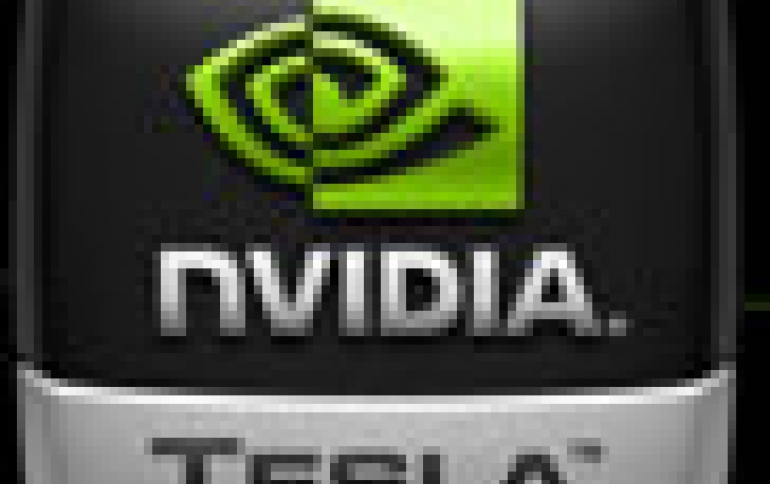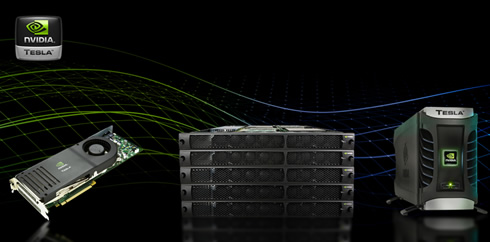
Nvidia Enters Computer Business Powered by Tesla GPU Processors
Nvidia announced today a family of GPU-powered computing products that promise to transform today's workstations into "personal supercomputers."
The new Tesla computer family promise to offer high-performance computing in fields like the geosciences, molecular biology, and medical diagnostics.
The new computers are powered by the Tesla GPU Computing Processor, a dedicated computing board that scales to multiple Tesla GPUs inside a single PC or workstation. The Tesla GPU features 128 parallel processors, and delivers up to 518 gigaflops of parallel computation. The GPU Computing processor can be used in existing systems partnered with high-performance CPUs.
Nvidia showcased the Tesla Deskside Supercomputer, a scalable computing system that includes two NVIDIA Tesla GPUs and attaches to a PC or workstation through a PCI-Express connection. Multiple deskside systems can be connected to a standard PC or workstation delivering up to 8 teraflops of compute power to the desktop.

In addition, NVidia announced the NVIDIA Tesla GPU Computing Server, a 1U server housing up to eight NVIDIA Tesla GPUs, containing more than 1000 parallel processors that add teraflops of parallel processing to clusters. The Tesla GPU Server is the first server system of its kind to bring GPU computing to the datacenter.
Computing on NVIDIA Tesla is available to software developers through NVIDIA's CUDA software development solution, the company's C-language development environment for the GPU. Programs written with CUDA and run on Tesla are able to process thousands of threads simultaneously, providing high computational throughput to enable the GPU to quickly solve complex, computational problems. The NVIDIA CUDA development environment is currently supported on the Linux and Microsoft Windows XP operating systems.
"Today's science is no longer confined to the laboratory; scientists employ computer simulations before a single physical experiment is performed. This fundamental transition to computational methods is forging a new path for discoveries in science and engineering," said Jen-Hsun Huang, president and CEO of NVIDIA. "By dramatically reducing computation times, in some cases from weeks to hours, NVIDIA Tesla represents the single most significant disruption the high-performance computing industry has seen since Cray 1's introduction of vector processing."
The first Tesla units are scheduled to go on sale this August. For more information and pricing details visit www.nvidia.com/tesla.
The new computers are powered by the Tesla GPU Computing Processor, a dedicated computing board that scales to multiple Tesla GPUs inside a single PC or workstation. The Tesla GPU features 128 parallel processors, and delivers up to 518 gigaflops of parallel computation. The GPU Computing processor can be used in existing systems partnered with high-performance CPUs.
Nvidia showcased the Tesla Deskside Supercomputer, a scalable computing system that includes two NVIDIA Tesla GPUs and attaches to a PC or workstation through a PCI-Express connection. Multiple deskside systems can be connected to a standard PC or workstation delivering up to 8 teraflops of compute power to the desktop.

In addition, NVidia announced the NVIDIA Tesla GPU Computing Server, a 1U server housing up to eight NVIDIA Tesla GPUs, containing more than 1000 parallel processors that add teraflops of parallel processing to clusters. The Tesla GPU Server is the first server system of its kind to bring GPU computing to the datacenter.
Computing on NVIDIA Tesla is available to software developers through NVIDIA's CUDA software development solution, the company's C-language development environment for the GPU. Programs written with CUDA and run on Tesla are able to process thousands of threads simultaneously, providing high computational throughput to enable the GPU to quickly solve complex, computational problems. The NVIDIA CUDA development environment is currently supported on the Linux and Microsoft Windows XP operating systems.
"Today's science is no longer confined to the laboratory; scientists employ computer simulations before a single physical experiment is performed. This fundamental transition to computational methods is forging a new path for discoveries in science and engineering," said Jen-Hsun Huang, president and CEO of NVIDIA. "By dramatically reducing computation times, in some cases from weeks to hours, NVIDIA Tesla represents the single most significant disruption the high-performance computing industry has seen since Cray 1's introduction of vector processing."
The first Tesla units are scheduled to go on sale this August. For more information and pricing details visit www.nvidia.com/tesla.




















